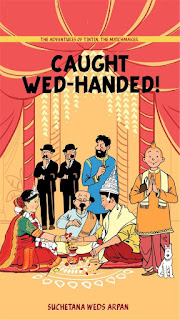All this happens in the ridiculously named kingdom of the Maharaja of Gaipajama, which translates literally into the "king of a cow's pyjama"! The India in Cigars of the Pharoah is utterly unreal and stuffed with awful caricatures. An argument with a cow, in fact, lands Snowy, Tintin's faithful companion, on the altar —ready to be sacrificed by angry Hindus, before he is saved by the bumbling detectives Thomson and Thompson, who prove useful in this case. The adventure ends happily, with Tintin — nattily dressed in a turban and shervani and accompanied by Snowy — joining his host, the Maharaja of Gaipajama, in a victory procession.
To many, Herge's depiction of India may seem too riddled with clichés and stereotypes, reflective of a European colonial mindset fuelled prejudices. But no one can deny the realism and painstaking detail which he brought into his narrative. For instance, when, in Tintin in Tibet, Captain Haddock bumps into a porter who yells at him in Hindi, Herge made sure that each word was correctly spelled out in the Devanagri script and that it was not just a meaningless hieroglyphics. It was this eye for detail that captivated noted film director Satyajit Ray — a self-confessed Tintin addict — who often referred to the stories in his films and books, especially in his famous Feluda detective series.
By the 1970s Hergé became interested in eastern philosophy and Tintin took to yoga in Tintin and the Picaros (1976).
Indians still love Tintin like no other comic book. It had been first translated into Bangla in 1976, and ever since Tintin and his dog "Kuttush" have enjoyed cult status in Bengal ever since. The comic was translated into Bengali by Nirendranath Chakraborty. Nirendranath Chakraborty is an important literary figure. He is one of those who created a unique poetic language. It is surprising that the Tintin series — which may have been ignored as ‘children’s literature’ — was appealing enough for him to put in so much introspection into the translation. So, it is not entirely unexpected that Chakraborty should use subtle nuances of language to give the characters of Tintin’s world a Bengali flavour while avoiding any blatant provincial element in their behaviour. The language of the translation retains the inherent mood of the original, even when the expressions are changed to fit an audience not acquainted with certain cultural references. What is equally remarkable is the congruity that Chakraborty’s language managed to maintain with Hergé’s drawings. It seems as though the faces drawn by Hergé were meant to speak in Bengali.
Perhaps there is something uniquely Bengali in Tintin. And that ‘something’ lies in Captain Haddock’s 'Jotto sob gneri-gugli-r jhnak' (billions of blue blistering barnacles), Professor Calculus’s endearing, deafness-induced confusion that is strangely familiar, and of course, Kuttush, the Bengali Snowy. Chakraborty had not only translated Tintin into Bengali, but had also incorporated in the comic a ‘Bengali-ness’ that draws us closer to it.
In fact, the adventures of Tintin have been so popular in the Bengal for years, it had led Herge, the creator of Tintin, to remark, "I receive a lot of mail from India. Here, in my office, are two letters from Calcutta. Now, what can there be in common between a boy in Calcutta and myself ?"
Nearly 5 decades later, Tintin finally spoke a second Indian language - the comic books were translated in Hindi in 2010. Tintin animation series had come out in Hindi much earlier and had been released on VCD/DVD in 2005. In the Hindi version, while Tintin remains the same, Snowy has been desi-fied to “Natkhat” and detectives Thomson and Thompson have been renamed “Santu and Bantu”. Captain Haddock’s ‘billions and billions of blue blistering barnacles’ has become ‘karodo karod kasmasate kaale kacchuve’ (millions and millions of squirming black turtles) while ‘ten thousand thundering typhoons’ reads as ‘dus hazaar tadtadate toofan’. Tintin’s catchphrase ‘Great snakes’ has been changed to ‘baal ki khaal’.
In an age of instant gratification and waning attention spans, Tintin albums - in English, and in Bengali and Hindi translations - continue to sell by the thousands. Is it any surprise then that Steven Spielberg's paean to the intrepid reporter, The Adventures of Tintin: The Secret of the Unicorn, released in India six weeks ahead of its the US release? Sony Pictures (India), which is released the film in India said that their research shows that more than 90% of the audience that watches Hollywood films in India are Tintin fans.
It is no wonder that artists across India are spending hours creating fan art of Tintin in various places across India.
- https://www.bbc.co.uk/news/15680397
- https://timesofindia.indiatimes.com/india/tintin-in-india-the-epic-that-wasnt/articleshow/2094744.cms?from=mdr
- https://www.telegraphindia.com/opinion/in-another-tongue/cid/476580
- https://www.scroll.in/article/827773/captain-haddock-in-calcutta-or-the-story-that-herge-did-not-write-
- https://tintinomania.com/tintin-herge-tintin-aux-indes
- http://myowntintin.blogspot.com/p/blog-page_20.html































































